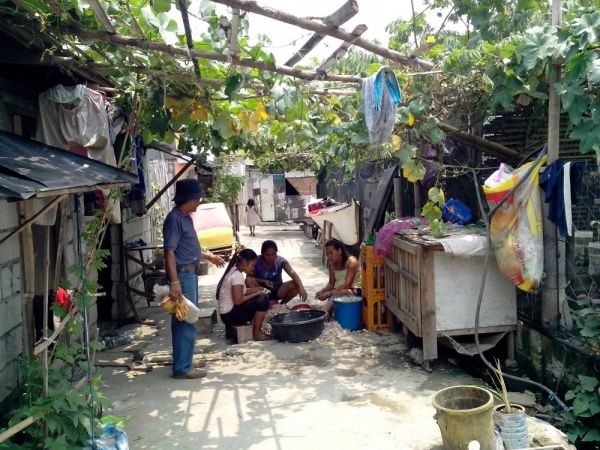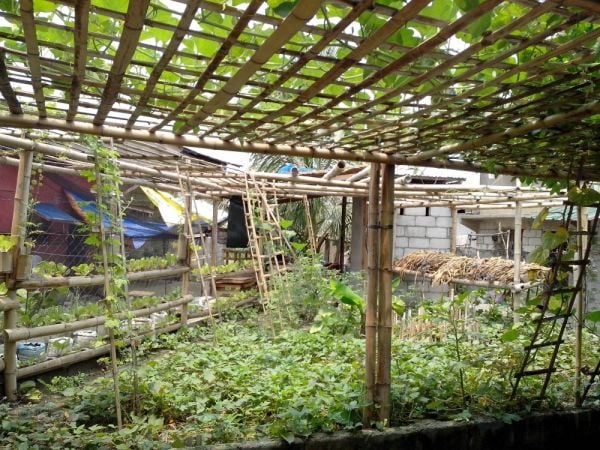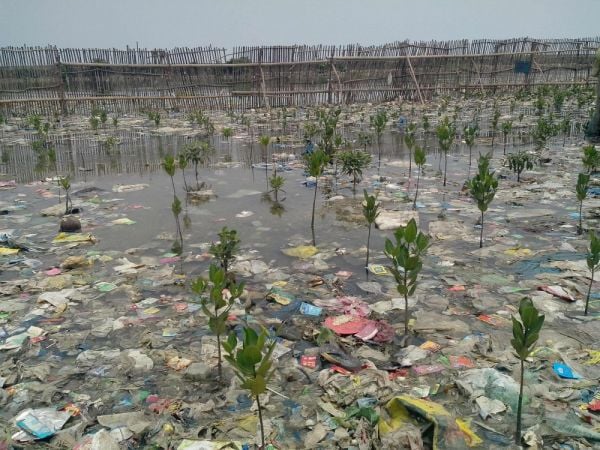Growing a Nest Egg Through Urban Gardening

The vegetable garden provides the community with produce, as well as a means to save.
It’s a peculiar sight: Russet soil, vines with vegetables growing out of them, green Chinese cabbage and violet eggplants, planted a few meters away from a sea of garbage and houses that have burned down several times.
But there it is, an estimated 80-square-meter vegetable garden with all kinds of plants, healthy and organic, grown by people in one of the biggest informal settlements in Manila. The garden not only provides food for the families in the village of Baseco, but also to customers from other parts of the capital.
The vegetables are grown by 600 members of Kabalikat sa Pagpapaunlad ng Baseco (Allies for Improving Baseco), an organization formed by the informal settlers in 2001 at a time when the 52-hectare port area was about to be zoned for socialized housing. Last year, Kabalikat received P100,000 ($2,300 USD) from Asian Bridge, a Korean NGO, and used the money to buy the land for the garden, vegetable seedlings and mangrove saplings.
In addition to the vegetable garden, the group mandates that its members grow food in their own “backyards.” Since the shanties are only 20 square meters, residents plant vegetables in makeshift pots made from plastic juice-drink containers.

Growing vegetables is a prerequisite to being part of the savings group.
Melanie Nieras, one of Kabalikat’s members, said she was able to save money by growing her own fruits and vegetables. “I buy seedlings from the market for P2 (less than one cent) then plant them,” she said. In a month’s time she could harvest her own lady’s fingers or gumbo. She said this is more economical than buying from the market, where one kilo of such produce could cost up to 81 cents.
Growing one’s own food is seen as a way to address hunger in Metro Manila. In 2012, a councilor in one of its densely populated cities, Quezon City, said that urban gardening in residences and even public schools could help combat malnutrition among children.
The hunger rate in Manila, according to the Social Weather Stations, a Filipino survey institute, has dropped to 21.7 percent in March from 25.3 percent in 2012. Still, 615,000 families cannot access three adequate meals per day. A report by the International Institute for Environment and Development released in March 2013 said that the incidence of hunger could increase further among the urban poor due to climate change. The report, “Urban Poverty, Food Security and Climate Change,” foresaw rising prices and instability in the agriculture sector as exacerbating the current threats to those already struggling.
For the people of Baseco, having their own vegetable gardens provides more than just food security. The organization also functions as a savings bank, the money from which will go toward the purchase of the land they have long dreamed to have.
“The members give a minimum of 23 U.S. cents each week. The group keeps the savings for them, which would be used to pay for the land here,” said Mayeth Betarolo, secretary of Kabalikat.
Baseco used to be notorious for its gangs and felons. When ousted president and convicted plunderer Joseph Estrada was replaced by the new chief executive Gloria Macapagal Arroyo, its land was reserved for socialized housing, and the people organized themselves to form Kabalikat. They drew up a people’s plan to remake the area. More than a decade later, however, with Arroyo now facing plunder charges herself, the land has yet to be fully reblocked and distributed to Baseco’s 12,000 occupants.
Still, the residents of Baseco, and particularly the members of Kabalikat, have not lost hope. They continued to improve their community with the help of other nongovernmental organizations such as the Urban Poor Associates. Patricia Revilles of Kabalikat said that the mangroves they’ve been planting will help prevent their houses from being swamped during typhoons. “Families of block five have had to transfer several times,” she said.

Hundreds of mangrove trees have been planted, but a stronger seawall is needed to keep garbage away from them.
Some 700 mangrove trees have been planted already. But when we visited the area, they were surrounded by fetid garbage from the sea. Plastic bags were strewn everywhere. A bamboo wall, constructed in late 2012 to keep the garbage from spilling over into the area where the mangroves were planted, had been destroyed by waves.
Petronilo Baliza, one of Kabalikat’s leaders, said they are looking for ways to raise more funds to have a stronger wall built. The aim, after all is to plant 10,000 mangrove trees by the end of this year. When asked if they accomplish that, he said: “We have a saying here: If you want to accomplish something, you’ll find ways to do it, come what may.”
A team of volunteers — mostly mothers — supervise the vegetable garden and mangrove trees. Each day one team member attends to them. They receive grocery items like coffee and canned goods in return. The same team is also in charge of selling the vegetables and mangrove saplings. One bundle of Chinese cabbage fetches for 23 cents. A mangrove sapling costs 46 cents.
When asked how she feels about the vegetable gardening being a condition of her savings account, Nieras said she understands why it’s necessary. “Others have left [the group] already, however,” she said. “Some think it’s not possible. They say, ‘How can we plant vegetables if we don’t have our own space?’” But Nieres believes in self-sufficiency, and trusts that the land in Baseco will one day be owned by Kabalikat outright.
Photos by Purple Romero









